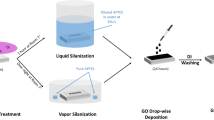Abstract
The surfaces of polyethylene naphthalate and polyethylene terephthalate films were modified by plasma treatment, layer-by-layer (LbL) assembly of polyelectrolyte multilayer thin films and subsequent deposition of SiO2 particles. Plasma treatment rendered the film surfaces hydrophilic and led to the formation of fibrillar patterns. The plasma-treated film surfaces were compatible with multilayers acquired via LbL assembly, and the outer adsorbed polyelectrolyte layer determined the charge of the multilayer surfaces. Negatively charged SiO2 particles were adsorbed to the positively charged surface of the multilayers. This process is potentially applicable to surface modifications of polymer materials by charged compounds.






Similar content being viewed by others
References
Beak BD, Ling JSG, Legget GJ (1998) Scanning force microscopy investigation of poly (ethylene terephthalate) modified by argon plasma treatment. J Mater Chem 8:1735–1742
Powell HM, Lannutti JJ (2003) Nanofibrillar surfaces via reactive ion etching. Langmuir 19:9071–9078
Teshima K, Sugimura H, Inoue Y, Takai O, Takanao A (2003) Ultra-water-repellent poly(ethylene terephthalate) substrates. Langmuir 19:10624–10627
Gonzalez E II, Barankin MD, Guschl PC, Hicks RF (2008) Remote atmospheric-pressure plasma activation of the surfaces of polyethylene terephthalate and polyethylene naphthalate. Langmuir 24:12636–12643
Wohlfart E, F-Blazquez JP, Knoche E, Bello A, Perez E, Arzt E, del Campo A (2010) Nanofibrillar patterns on PET: the influence of plasma parameters in surface morphology. Macromolecules 43:9908–9917
Fleischman MS, Lee BS, R-Santiago V, Chhasatia V, Sun Y, Pappas DD (2012) Hybrid method involving atmospheric plasma treatment and inkjet deposition for the development of conductive patterns on flexible polymers. Surf Coat Technol 206:3923–3930
Yang GH, Kang ET, Neoh KG (2001) Surface graft copolymerization of poly(tetrafluoroethylene) films with N-containing vinyl monomers for the electroless plating of copper. Langmuir 17:211–218
Farhan T, Huck WTS (2004) Synthesis of patterned polymer brushes from flexible polymeric films. Eur Polym J 40:1599–1604
Yang P, Yang W (2014) Hydroxylation of organic polymer surface: method and application. ACS Appl Mate Interfaces 6:3759–3770
Kim Y-J, Taniguchi Y, Murase K, Taguchi Y, Sugimura H (2009) Vacuum ultraviolet-induced surface modification of cyclo-olefin polymer substrates for photochemical activation bonding. Appl Surf Sci 255:3648–3654
Nie H-Y, Walzak MJ, Berno B, McIntyre NS (1999) Atomic force microscopy study of polypropylene surfaces treated by UV and ozone exposure: modification of morphology and adhesion force. Appl Surf Sci 144–145:627
Ayres N (2010) Polymer brushes: applications in biomaterials and nanotechnology. Polym Chem 1:769–777
Ohno K, Kayama Y, Ladmiral V, Fukuda T, Tsujii Y (2010) A versatile method of initiator fixation for surface-initiated living radical polymerization on polymeric substrates. Macromolecules 43:5569–5574
Kimura M, Yamagiwa H, Asakawa D, Noguchi M, Kurashina T, Fukawa T, Shirai H (2010) Site-selective electroless nickel plating on patterned thin films of macromolecular metal complexes. ACS App Mate Interface 2:3714–3717
Decher G, Hong JD, Schmitt J (1992) Buildup of ultrathin multilayer films by a self-assembly process: III. Consecutively alternating adsorption of anionic and cationic polyelectrolytes on charged surfaces. Thin Solid Films 210(211):831–835
Wang TC, Chen B, Rubner MF, Cohen RE (2001) Selective electroless nickel plating on polyelectrolyte multilayer platforms. Langmuir 17:6610–6615
Lee I (2013) Molecular self-assembly: smart design of surface and interface via secondary molecular interactions. Langmuir 29:2476–2489
Lvov Y, Ariga K, Onda M, Ichionose I, Kunitake T (1997) Alternate assembly of ordered multilayers of SiO2 and other nanoparticles and polyions. Langmuir 13:6195–6203
Caruso F, Lichtenfeld H, Giersig M, Mohwald H (1998) Electrostatic self-assembly of silica nanoparticle-polyelectrolyte multilayers on polystyrene latex particles. J Am Chem Soc 120:8523–8524
Wang F, Peters S, Guzda J, Blunk RH, Angelopoulos AP (2009) Silica nanoparticle layer-by-layer assembly on gold. Langmuir 25:4384–4392
Srivastava S, Kotov NA (2008) Composite layer-by-layer (LBL) assembly with inorganic nanoparticles and nanowires. Acc Chem Res 41:1831–1841
Friebe A, Ulbrich M (2007) Controlled pore functionalization of poly(ethylene terephthalate) track-etched membranes via surface-initiated atom transfer radical polymerization. Langmuir 23:10316–10322
Chen W, McCarthy TJ (1997) Layer-by-layer deposition: a tool for polymer surface modification. Macromolecules 30:78–86
Hagen DA, Foster B, Stevens B, Grunlan C (2014) Shift-time polyelectrolyte multilayer assembly: fast film growth and high gas barrier with fewer layers by adjusting deposition time. ACS Macro Lett 3:663–666
It is considered that residual air forms oxygen and nitrogen plasma in the vacuum plasma apparatus chamber, and then oxygen and nitrogen atoms are introduced to the polymer surface.
Richards RR, Rogowski RS (1974) Thermally stimulated chemiluminescence in photo-oxidized poly(ethylene 2,6-naphthalene dicarboxylate). J Polym Sci Part B: Polym Phys 12:89–96
Allen NS, Mckellar JF (1978) Photochemical reactions in commercial poly(ethylene 2,6-naphthalate). J Appl Polym Sci 22:2085–2092
Watanabe M, Nakamura Y, Shinagawa T, Watase S, Tamai T, Nishioka N, Matsukawa K (2013) Highly c-axis oriented deposition of zinc oxide on an ITO surface modified by layer-by-layer method. Electrochim Acta 96:237–242
Tamai T, Ichinose N, Kawanishi S, Mizuno K (2000) Photochemical oxygenation and cross-linking of poly(4-trimethylsilylmethylstyrene) thin film by UV irradiation. Macromolecules 33:2881–2886
Tamai T, Watanabe M, Ikeda S, Kobayashi Y, Fujiwara Y, Matsukawa K (2012) A Pd nanoparticle/silica nanoparticle/acrylic polymer hybrid layer for direct electroless copper deposition on a polymer substrate. Chem Lett 41:277–279
Matsusaki M, Ajiro H, Kida T, Serizawa T, Akashi M (2012) Layer-by-layer assembly through weak interactions and their biomedical applications. Adv Mater 24:454–474
Acknowledgments
This study was partly supported by a Grant-in-Aid for Scientific Research (C) (25410135) from the MEXT of Japan. We would also like to thank Nissan Chemical Co., Ltd. for a gift of colloidal silica.
Author information
Authors and Affiliations
Corresponding author
Electronic supplementary material
Below is the link to the electronic supplementary material.
ESM 1
(DOC 13722 kb)
Rights and permissions
About this article
Cite this article
Tamai, T., Watanabe, M. & Mitamura, K. Modification of PEN and PET film surfaces by plasma treatment and layer-by-layer assembly of polyelectrolyte multilayer thin films. Colloid Polym Sci 293, 1349–1356 (2015). https://doi.org/10.1007/s00396-015-3518-7
Received:
Revised:
Accepted:
Published:
Issue Date:
DOI: https://doi.org/10.1007/s00396-015-3518-7




